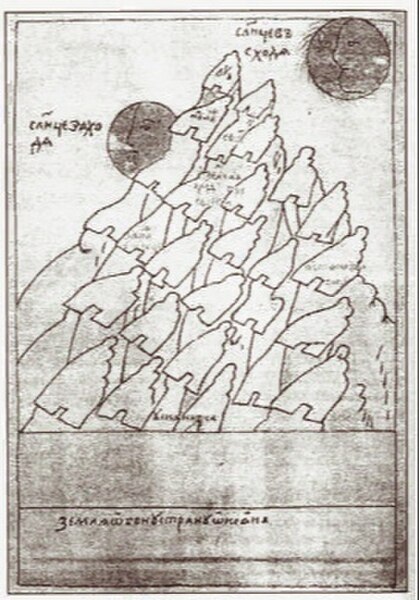Rus' chronicle or Russian chronicle or Rus' letopis was the primary type of Rus' historical literature. Chronicles were composed from 11th to 18th centuries, generally written in Old East Slavic about Kievan Rus' and subsequent Rus' principalities and histories. Chronicles were one of the leading genres of Old Rus' literature, and were prominent in medieval and early modern Eastern and Central Europe.
Tale of Bygone Years (Primary Chronicle) in Radziwiłł Chronicle of 15th century.
Letopisets. Novoseltsev A. N.
Illustration from the Slavic edition of "Christian Topography". Caption at the bottom: "World on the other side of the door"
Alexey Shakhmatov, creator of a large-scale genealogy of letopis lists
Old East Slavic literature
Old East Slavic literature, also known as Old Russian literature, is a collection of literary works of Rus' authors, which includes all the works of ancient Rus' theologians, historians, philosophers, translators, etc., and written in Old East Slavic. It is a general term that unites the common literary heritage of Russia, Belarus and Ukraine of the ancient period. In terms of genre construction, it has a number of differences from medieval European literature. The greatest influence on the literature of ancient Rus' was exerted by old Polish and old Serbian literature.
The Evangelist John, a miniature from the Ostromir Gospel, mid-11th century
Izmaragd, early 14th century
"The Hand of John of Damascus". Medieval method for calculating the Paschal calendar. On the left: "the hand of Damaskin", on it 28 circles to the Sun — red Slavic numbers Old Slavonic alphabet, under each of them "vruceleto", each circle of the Sun — black Slavic numbers. On the right: "the Jewish hand", on it 19 lunar circles — red Slavic numbers, under each of them the Easter border, each circle of the Moon — black Slavic numbers.
Simeon of Polotsk. The poem in the form of a star "Greeting to Tsar Alexei Mikhailovich on the occasion of the birth of Tsarevich Simeon".








